| | The amount of habitat available for wildlife has been greatly reduced in agricultural areas of Alberta. This has occurred largely because forests have been cleared to allow farmers to cultivate crops or graze cattle. The effects of forest clearing have accumulated over time and space so that changes that individually might be considered relatively small have combined to greatly reduce the amount and value of wildlife habitat. Part of the problem is that most wildlife tends to avoid cultivated fields and land that has been affected by intensive cattle grazing. As a result, wildlife in many areas has become increasingly dependent on the few woodlots that still remain.
Because of this, woodlots provide much of the wildlife habitat that remains in agricultural areas. Although the majority of woodlots provide better wildlife habitat than cultivated fields and pasture, a woodlot’s value for wildlife depends largely on how it is managed. For example, woodlots that have had the understory removed and trampled by intensive cattle use are much less valuable to wildlife than those that have not.
Fragmentation
Forest fragmentation is a process in which large areas of continuous forest are divided into smaller isolated blocks. This may result from timber harvesting, wild fires, agricultural practices, such as cattle grazing and crop production, or a number of other factors. In the case of agriculture, fragmentation is more or less permanent. However, fragmentation from timber harvesting or fire is usually temporary, although the effects may last for several decades. Because forested habitat has almost disappeared in many parts of the province, the areas that remain are often small and widely scattered. These conditions can lead to reduced populations of some wildlife species and the disappearance of others, particularly those that require large areas of habitat. One problem is that animals become confined to small areas of good habitat and have little opportunity to move into other areas. This problem is especially serious for animals that are unwilling to cross open areas between blocks of forest cover. Confining animals to small habitat units can increase inbreeding and reduce a population’s ability to adapt to changing circumstances. This, in turn, can increase the impact of disease and various types of disturbance on a wildlife species.
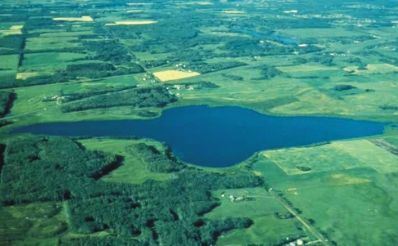
Forest Fragmentation in Agricultural Zone
Source by: Ducks Unlimited Canada
Edge is the transition zone between two habitat types, such as grassland and forest. Edges are often important for wildlife because an edge often contains species that occur in each of the adjoining habitat types as well as species that are unique to the edge itself. As fragmentation increases, the amount of forest edge also increases. Increasing the amount of edge can lead to increased diversity. Increasing amounts of sunlight can stimulate shrub growth and lead to increased use by species like deer and moose that eat shrubs. On the other hand, increasing the amount of forest edge may increase the abundance of common species while leading to lower populations of some uncommon species. This occurs because uncommon or rare species often reside in the interior of forest stands, which declines as the amount of edge increases. The creation of edges may also lead to the invasion of non-native and weedy plant species.
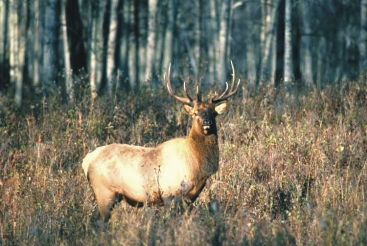
Edge effect is very important for many wildlife species
Source by: Ducks Unlimited Canada
Woodlot structure and biodiversity
In general, the value of a woodlot to wildlife increases as its structure becomes more complex. Many animals benefit from the presence of trees, which provide both hiding cover and protection from severe weather. These benefits are increased if the woodlot contains some large coniferous trees, such as white spruce, because coniferous trees provide hiding cover throughout the year. In addition, by bedding under coniferous trees or perching in their branches, an animal can stay warm by reducing the loss of its body heat into the atmosphere. Conifers can also make it easier for animals to travel and feed by reducing the amount of snow on the ground. In this way, conifers can greatly increase the value of a woodlot as wildlife cover during poor weather. Mature spruce trees are also important for red squirrels, which use the seeds of both white and black spruce as food.
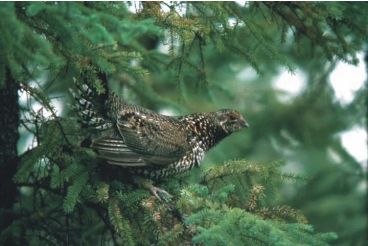
Ruffed Grouse on spruce tree
Source by: Ducks Unlimited Canada
Habitat diversity increases as the number of layers in a woodlot increases; this layering is also known as vertical stratification. A forest can have many layers. These layers may include a layer of grasses and forbs, low and tall shrub layers, and a number of tree layers based on the species composition and age structure of the stand. Vertical stratification is associated with the abundance and diversity of forest birds because different species often occupy different parts of the forest. For example, solitary vireos tend to nest less than 4.5 m from the ground, whereas Cape May warblers usually nest near the tops of the tallest conifer trees in a stand. Some wildlife species also use different parts of the forest for different activities; for example, solitary vireos often breed in areas of deciduous cover but usually nest where there are more conifers. The ruffed grouse is another species that can benefit from forest diversity. Although this bird is usually found in aspen stands at all times of the year, aspen forest over 40 years old is preferred by breeding birds, whereas stands that are around 10 years old provide the best habitat for newly hatched broods.
Although tree cover is an important component of forest stands, the presence of a well developed shrub layer is also essential for many wildlife species. Shrubs, such as willow, pincherry, chokecherry and red-osier dogwood, provide much of the food eaten throughout the year by moose, white-tailed deer, mule deer and snowshoe hares. Many forest-dwelling mice, voles and shrews are also most abundant in habitats that have a dense shrub layer. Many of these species are important in forest regeneration because they disperse seeds. These small animals are also important prey for a variety of predatory birds and mammals.
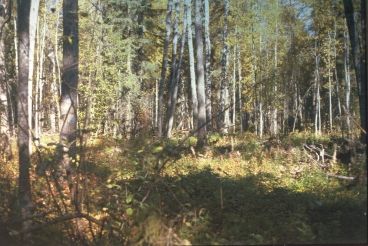
Diverse forest structure provides better habitat for wildlife
Photo by: Douwe Vanderwel- AAFRD
Standing dead trees and deadfalls also contribute to the value of a woodlot as habitat for wildlife. Standing dead trees provide roosting sites and habitat for birds and mammals that prefer to nest in cavities. Woodpeckers feed in standing dead trees and also make nest cavities in these trees. Some other birds, such as some species of ducks, nest and raise their young in cavities created by other wildlife. Flying squirrels are often found in cavities in dead trees and some species of bats also usually occur in habitats with standing dead trees, which are used for roosting sites.
Deadfalls provide hiding cover and runways for smaller animals like mice, voles and shrews, and, because they are often infested with insects, also provide food for insectivores and sometimes larger animals, such as black bears. In some areas, animals like fishers and lynx build their dens in deadfalls.
Riparian woodlots
Areas next to the water, which are called riparian habitats, are important in the ecology of a variety of fish and wildlife species. Forested riparian areas are important because they often provide a combination of water, forage and cover. Naturally vegetated riparian areas increase the value of water for fish by stabilizing shorelines. They also reduce the amount of sediment that goes into ponds, lakes and streams. Sediment can damage spawning habitat, which can reduce spawning success or kill eggs and fry, and lead to lower fish populations. The ability of fish to feed may also be reduced in waters that have been affected by sedimentation. Shoreline vegetation also provides shaded areas that can reduce heat stress in fish.
Riparian habitats are also important to a variety of mammals and birds. Woodlots located near water provide nesting habitat and cover for many species of waterfowl and shorebirds, and also provide food and construction materials for beavers. Although beavers are sometimes considered a pest because they cut down trees and build dams, which may cause unwanted flooding, they are ecologically important because the ponds that they create can provide habitat for fish. As well, beaver ponds often support a variety of waterfowl and shorebirds. Mammals, such as muskrats, mink and otter are also often associated with beaver ponds. By cutting trees, beavers increase the abundance shade-intolerant shrubs, which increases forage production for animals, such as moose, deer and hares, which feed by browsing on shrubs.
Large river valleys frequently provide important wintering habitat for wildlife because they often have abundant forage and cover. Mammals that spend the winter in underground dens or use them to bear their young often construct them near lakeshores and streams on fairly dry sites with suitable soils. Wildlife movement corridors also frequently follow forested riparian areas. Riparian areas also provide nesting sites for breeding birds and resting sites for migratory birds. Consequently, these areas are highly important to a variety of wildlife species.
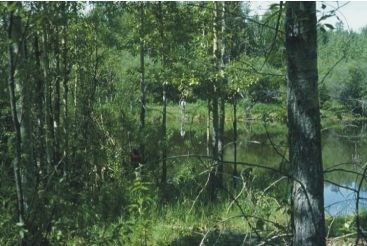
Riparian zone is critical for many wildlife species
Source by: Duck Unlimited Canada
Woodlot management and wildlife
Because woodlots are usually small and scattered, their management differs from that used in large areas of continuous forest. Proper woodlot management can secure, improve and diversify wildlife habitat while keeping the woodlot healthy and productive. Ecological diversity will increase and many wildlife species will benefit if wildlife values are considered in woodlot management.
If the intention is to manage for both wildlife and timber harvesting, the selective removal of trees should be considered. This is because a selective timber harvest can create an uneven-aged stand, promote shrub growth in forest openings and increase the number of vegetative layers. Thus, selectively cutting a stand can promote the development of a herb layer, shrub layer and several layers of trees of various ages. In contrast, clearcutting removes all of the trees in a stand and temporarily removes most of the habitat for forest dwelling animals. In some cases, it may take one or two decades for a wildlife species to repopulate an area after it has been clearcut. In addition, after it regenerates, a clearcut usually becomes even aged, which results in less habitat diversity, fewer layers, and therefore less abundant wildlife with fewer species than a stand that has been selectively cut. Nevertheless, some wildlife species can benefit from a clearcut after shrubs begin to regenerate, provided that the opening is not too large and not too far from forest cover. Species that may benefit include snowshoe hares, moose, elk and deer. Predators of these species may also increase in response to the increased abundance of prey and improved hunting opportunities.
In managing woodlots for wildlife, the woodlot owner has to recognize that it will not be possible to manage for all wildlife species. The landowner will therefore have to determine the potential of his land for various species and develop a management plan that will retain or create suitable habitat for those of interest. For example, a management plan for deer and moose might involve providing a mix of regenerating small clearcuts and mature mixedwood forest.
Some management options that should be considered are:
- Using a variety of harvesting methods to diversify forest structure.
- Making sure that cutblocks are irregular in shape. This increases forest edge and is also aesthetically more pleasing than rectangular cutblocks.
- Leaving some clumps of large standing trees in cutblocks to reduce the distance that animals have to travel to cover. These will also promote regeneration of the stand.
- Some standing dead trees and deadfalls should also be left to provide habitat for species like woodpeckers, cavity nesting birds and mammals, and small mammals.
- Planting coniferous trees under the deciduous canopy to increase plant species diversity, age structure and the number of forest layers. This, in turn, will lead to increased wildlife
- Leaving some areas of high density forest to provide cover for wildlife.
- Allowing only limited cattle grazing in the woodlot and removing cattle during the reproductive period for most wildlife species (April-June).
- Reforesting and re-vegetating to provide wildlife movement corridors between existing forest stands.
- Maintaining water quality, wetland conservation and wildlife values by not cutting trees in riparian areas.
In most cultivated areas of Alberta, woodlots provide the best habitat for wildlife. These woodlots can therefore lead to a greater enjoyment and appreciation of nature by enhancing outdoor recreational activities like wildlife viewing, bird watching and hunting. However, uneven aged woodlots, which have a complex structure, usually have greater wildlife diversity than even aged stands, which are less complex. Consequently, it is often possible for landowners to maintain or even improve wildlife habitat in woodlots through careful planning and management.
For more information on wildlife in Alberta please visit Alberta Fish and Wildlife.
For more information on managing woodlot habitat for wildlife, visit Alberta Conservation Association, or Cows and Fish. |
|